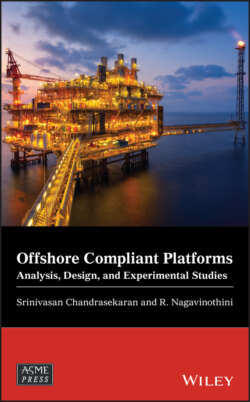Читать книгу Offshore Compliant Platforms - Srinivasan Chandrasekaran - Страница 13
Preface
ОглавлениеThis book, Offshore Compliant Platforms: Analysis, Design, and Experimental Studies, describes detailed analysis and design procedures for compliant offshore structures, with a special focus on new‐generation platforms like the triceratops and buoyant leg storage and regasification platforms. While the conceptual development of conventional platforms like tension leg platforms (TLPs), spar platforms, and articulated towers is presented briefly, the detailed descriptions of the design and development of new‐generation platforms discussed in the book are highly novel and still in the preliminary stages of study in the existing literature.
Compliant offshore platforms are favorable candidates for deepwater oil and gas production systems due to their form‐dominant design characteristics. But significant compliancy causing flexible motion in the horizontal plane requires special attention from designers because it poses critical challenges when platforms are commissioned in ultra‐deep water. Therefore, a novel geometric form with reduced responses is a vital necessity to accommodate extreme loading.
This book presents a detailed analysis and design of one such novel platform: the triceratops. The authors believe that it will serve as a good reference guide for the effective design of triceratops platforms, as the clear numerical and experimental studies presented in the book will help readers understand the platforms' dynamic response behavior. A new methodology for the dynamic analysis of a triceratops under ice loads in ice‐covered regions is also explained with detailed parametric studies. Offshore platforms are also prone to accidental loads arising due to fires and ship–platform collisions; the detailed dynamic analysis under such loads that is presented in the book will be of great interest to both researchers and practicing structural consultants.
In addition, this book will aid in understanding the platform's structural behavior in terms of its response, service life, and design. The book will serve as a resource regarding the basic structural behavior of complex offshore structures; it will help graduate students understand analysis methodologies and will also help researchers understand the dynamic response of such structures. Readers will learn about new structural geometries of offshore platforms and different methods of analysis for assessing their performance under special loads. The discussion of fatigue analysis and predicting service life will also help professionals during the preliminary and detailed design stages of offshore platforms. This book can serve as reference material for both academicians and offshore practicing professionals.
Both senior undergraduate and post‐graduate students in the disciplines of civil, mechanical, aerospace, structural, offshore, and ocean engineering; applied mechanics; and naval architecture will find this book very useful as a standard classroom reference for analysis and design of special structures. In addition, this book will be useful for practicing engineers and research scholars studying the response behaviors of structures with novel geometry under combinations of extreme loads.
The experimental studies and numerical analyses discussed in the book are the outcomes of research work carried out recently by the authors and research scholars supervised by Srinivasan Chandrasekaran. All discussions, interpretations, and concepts conceived during the detailed research work carried out by the research scholar team are sincerely acknowledged. Administrative support extended by the Centre for Continuing Education (CCE), Indian Institute of Technology, Madras in preparing this manuscript is sincerely acknowledged.
Srinivasan Chandrasekaran
R. Nagavinothini
